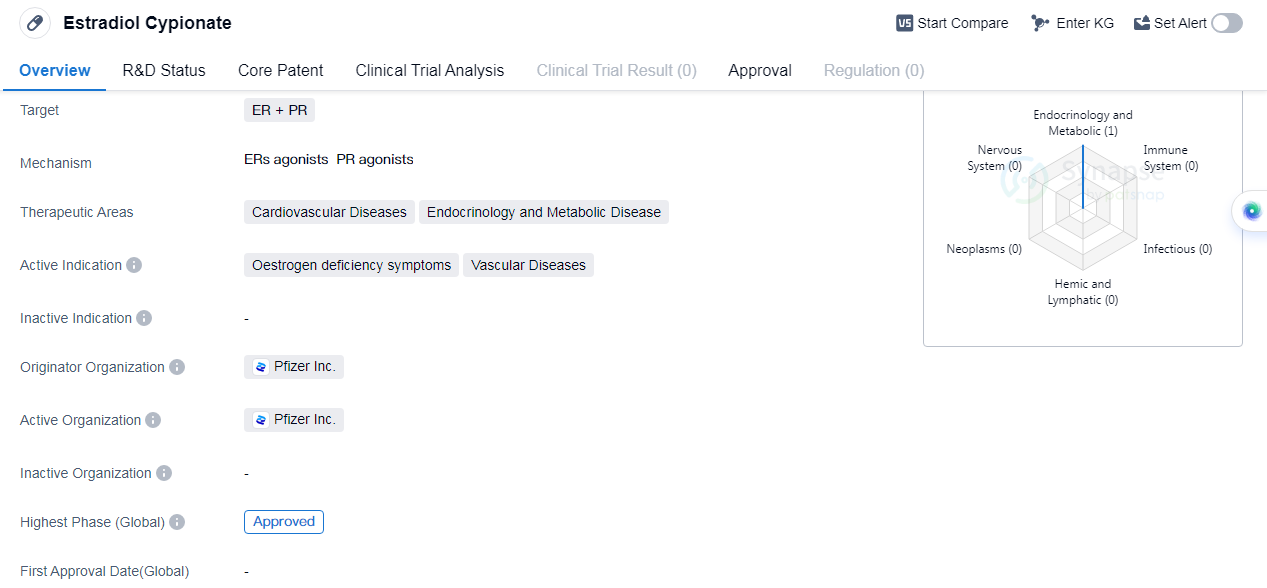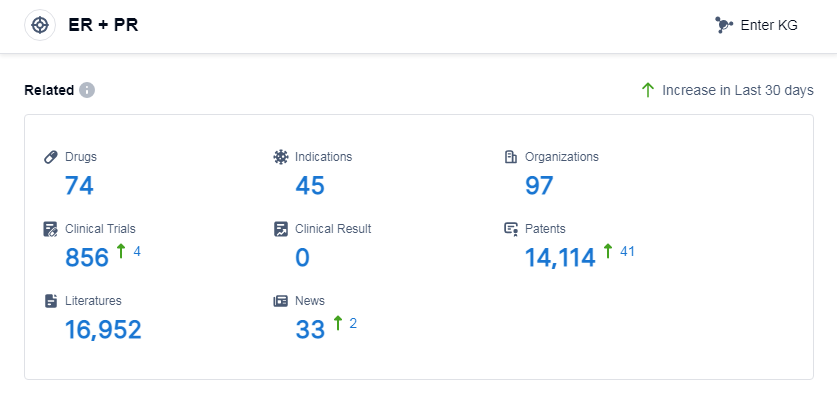Decoding Estradiol Cypionate: A Comprehensive Study of its R&D Trends and Mechanism on Drug Target
Estradiol Cypionate's R&D Progress
Estradiol Cypionate is a small molecule drug that targets ER and PR, which stands for estrogen receptor and progesterone receptor, respectively. This drug is primarily used in the treatment of cardiovascular diseases, endocrinology, and metabolic diseases, and it is specifically indicated for the management of symptoms related to estrogen deficiency and vascular diseases.
Estradiol Cypionate is developed by Pfizer Inc., a renowned pharmaceutical company. It has successfully completed all phases of clinical trials and has received approval for global use.
Cardiovascular diseases are a leading cause of mortality worldwide, and the therapeutic potential of Estradiol Cypionate in this area is significant. Estrogen deficiency is commonly found in postmenopausal women, and it is associated with an increased risk of cardiovascular diseases. By targeting ER and PR, Estradiol Cypionate aims to alleviate the symptoms of estrogen deficiency and potentially reduce the risk of cardiovascular complications.
Endocrinology and metabolic diseases encompass a wide range of conditions, including hormonal imbalances and disorders related to metabolism. Estradiol Cypionate may play a crucial role in managing these conditions by restoring hormonal balance and addressing the underlying causes.
Vascular diseases, such as atherosclerosis and peripheral artery disease, are characterized by the narrowing or blockage of blood vessels, leading to reduced blood flow and potential organ damage.
👇Please click on the image below to directly access the latest data (R&D Status | Core Patent | Clinical Trial | Approval status in Global countries) of this drug.
Mechanism of Action for Estradiol Cypionate: ERs agonists and PR agonists
ERs agonists and PR agonists refer to compounds or substances that activate the estrogen receptors (ERs) and progesterone receptors (PR) in the body, respectively.
From a biomedical perspective, ERs agonists are compounds that bind to and activate the estrogen receptors, which are proteins found on the surface of cells. ERs play a crucial role in various physiological processes, including the regulation of reproductive tissues, bone health, and cardiovascular function. By activating these receptors, ERs agonists mimic the effects of estrogen in the body.
Similarly, PR agonists can bind to and activate the PR. PR are also proteins found on the surface of cells and are involved in regulating the female reproductive system, particularly during the menstrual cycle and pregnancy. PR agonists mimic the effects of progesterone and can influence various biological processes related to reproduction and pregnancy.
Both ERs agonists and PR agonists are used in biomedical research and clinical practice for their ability to selectively target and activate specific receptors. These compounds can be utilized to study the role of estrogen and progesterone signaling pathways, as well as to develop therapeutic interventions for conditions such as hormone-dependent cancers, menstrual disorders, and infertility.
Drug Target R&D Trends for Estradiol Cypionate
According to Patsnap Synapse, as of 5 Sep 2023, there are a total of 74 ER and PR drugs worldwide, from 97 organizations, covering 45 indications, and conducting 856 clinical trials.
The current competitive landscape for the target ER and PR is dominated by companies such as Bayer AG, Pfizer Inc., and Chemical Works of Gedeon Richter Plc. These companies have a significant number of drugs in the approved phase, the most common indications for these drugs are contraception, osteoporosis, postmenopausal, pregnancy, and menopausal syndrome. Small molecule drugs are the most rapidly progressing drug type for the target ER and PR, with a significant number of drugs in the approved phase. China is one of the leading countries/locations in terms of drug development for the target ER and PR. Overall, the target ER and PR shows promise for future development, particularly in the areas of women's health and hormonal disorders.
👇Please click on the picture link below for free registration or log in directly if you have a freemium account, you can browse the latest research progress on drugs, indications, organizations, clinical trials, clinical results, and drug patents related to this target
Conclusion
In summary, Estradiol Cypionate is a small molecule drug developed by Pfizer Inc. It targets ER and PR, and it is indicated for the treatment of estrogen deficiency symptoms and vascular diseases. With its approval and potential therapeutic benefits in cardiovascular diseases, endocrinology, and metabolic diseases, Estradiol Cypionate holds promise in improving patient outcomes in these therapeutic areas.






